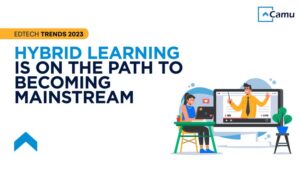
EdTech Trends 2023: Gamify Your Offerings for better Tech Adoption
As an academic, you would have come across the term ‘gamification’ being used in conjunction with teaching and learning.
The last 3 years, especially, have been abuzz with this keyword.
But what does it mean exactly?
And what impact does it have on modern education?
Will institutes benefit from incorporating this into their curriculums?
More importantly, how does it influence student outcomes?
In our fourth blog of the Camu-EdTech-Trends series, we break down the concept of gamification and outline its implications for 2023.
It’s not all fun and games, in fact, this discipline is the outcome and goal-oriented!
Gamification: The Science of Making Learning Fun
Ever since 1982, computer games have demonstrated the inherent ability to engage users, so much so that educators were quick to recognize the merits of adopting them to impart knowledge.
Gamification – in the context of education – can be described as the use of game-design elements and/or game-based principles to create a three-fold impact:
- Engage with students
- Help them assimilate new information
- Test their knowledge and skills
The insight behind the gamification theory is that students learn best when they are having fun. Moreover, they are motivated and inclined to learn more when they have concrete goals and targets to reach.
By applying game-based principles such as point scoring, peer competition, and teamwork, to learning materials, students are provided with an incentive to improve their performance and productivity.
Using the psychology of positive reinforcement, a reward system elicits certain desirable behavioral traits from students, such as higher interest, curiosity, receptiveness, and diligence.
Additionally, a game model helps to simplify complicated theories and enables a deeper understanding of concepts.
From traditional game elements like puzzles and quizzes to digital game elements such as VR simulations, the stakes in gamification have only gone up.
And with the widespread adoption of technology in institutes, gamification is developing into a key player of the virtual classroom.
Applications of Gamification in 2023
While gamification has been around since 2010, it has only emerged as a promising education model in more recent times.
This can be attributed to the rise of EdTech usage, along with increasing expectations of student centricity.
Those who have been successful in implementing game mechanics into their offerings, have witnessed students transform from passive participants to active ones.
Here’s how different game elements can be used to enhance the engagement and learning of students in 2023:
- Point systems can be used to encourage students to meet their academic objectives and move up the ranks. For instance, 1 point is awarded to students who provide the correct answer, whereas 2 issues are up for grabs for those who cite a valid example.
- Leaderboards can be used to track learner progress and display top scorers to the entire class. By allowing students to view their precise position within the game, they will know exactly what strategy to deploy in order to move up.
- A digital universe can be built, wherein each student is represented by their own virtual avatar. The avatar must take certain actions to amass points. This works especially well when aspects like socialisation, collaboration and teamwork have to be tested.
- Simulations can be used to allow learners the opportunity to interact with the environment and characters of the game. This self-learning tool helps students understand complicated theories as they are learning by doing.
- AI applications can be used to provide real-time feedback and personalised recommendations to students based on their current performance within the game. These prompts will provide them with a competitive edge to move forward.
- AI-driven features can be used to customize games based on a student’s learning style and pace. This allows learners to progress in a self-directed way, highlighting specific areas in which they require further assistance.
As gamification continues to evolve in 2023, institutes should look to incorporate some of its aspects into curriculums and lesson plans.
This is because learning becomes so much more engaging, interactive and personalised with game thinking.
Furthermore, learning is much more visible through precise progress indicators.
The best part is, there is an opportunity to be creative, explore, discover and grow.
If this something that piques your interest, reach out to us, and we’d be happy to show you how you can leverage it for your institute.







